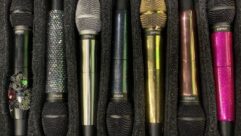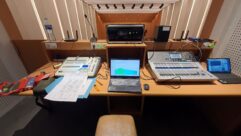Magic in the SoundAt magician Lance Burton’s Las Vegas theater, sound envelops the crowd, disappears and reappears.
Feb 20, 1997 12:00 PM,
Keith ClarkClark is public relations manager at Eastern Acoustic Works, Whitinsville, MA.
Many magical feats are done with mirrors. At the Lance Burton Theater, home of magician Lance Burton, at the Monte Carlo Resort and Casino in Las Vegas, the magic is done with a digital hard-disk recorder, two digital mixers and a mixing console.
“We conceived of a sound system that would provide a three-dimensional environment for music, the biggest element of the audio portion of the show,” said Michael Cusick, president of Specialized Audio-Visual Inc. (SAVI), Clifton Park, NY, which designed and installed the system.
Cusick worked with Nick Thorpe, Burton’s musical director, to create the show’s soundtrack. They developed a process by which multitrack music recordings done in studio could be brought into the theater and recorded on a 16-channel digital audio workstation. All final mixdown, editing, level settings, assignments to the loudspeakers and the like were done in exactly this manner.
“The goal was to create a musical score played back through a multichannel sound system, essentially like painting a soundscape in the space surrounding each listener,” Cusick said. “This wasn’t, in any sense at all, a traditional two-track recording.”
The theater itselfThe $15 million theater offers seating for 1,300 in three main sections: main level, balcony and under-balcony. Cecil Dover of Dougall Design Associates created the 1920s vaudeville-style interior. The room’s shape, wall covering and detailing are of a traditional theater nature and style, with the stage proscenium and box seating areas adorned with elaborately designed wood and plaster-like treatments.
Cusick and Dover worked closely to maintain the integrity of this carefully crafted look. Despite the fact that the audio system includes 16 discrete channels feeding 104 loudspeakers, it’sall so well concealed and camouflaged that the audience doesn’t see even asingle loudspeaker.
The only “official” acoustic treatment can be found on the ceiling, where a cellulose fiber material was sprayed over the plaster board to cut reflections. “Acoustically, the room is a nice balance between a nonreverberant ‘dry’ room and an overly reverberant barn-like space,” Cusick said. “We were also fortunate that the room is small enough that long reverberation times canbe avoided.”
Science is the keyForming the heart of the front-end of the system are three advanced digital devices: an Otari RADAR 24-track digital hard-disk recorder, two Level Control System (LCS) LD-88 digital mixers and an Amek Langley Recall mixing console. The first 16 channels of the RADAR recorder were used for the music soundtrack, with eight tracks reserved for sound effects. The entire recorded soundtrack uses 12 gigabytes of hard disk storage for the 11/2-hour show.
Each LCS LD-88 digital mixer supplies eight channels of 20-bit audio I/O, eight audio processing DSPs and a control DSP. The two used for this project were combined, creating a 16-channel programmable matrix, which allowed the designers to map out sound location and motion. With 16 tracks distributed to 16 channels (plus eight channels of effects), any sound can be routed hundreds of different ways. The combination of the hardware and specialized LCS software even allows the designer to move sound throughout a desired area or the entire soundstage.
The digital audio workstation feeds the source tracks to the LD-88, where movements were created and programmed, and this input is fedto the RADAR recorder, which captures an “encoded” 16-channel mix plussound effects.
For example, an orchestral arrangement could, via the LD-88, be split into a new arrangement where the string section is fed to loudspeakers to the far left and right of the audience, while brass originates from above the proscenium and certain vocal choruses emanate from rear channels.
By using the 16-channel sound system as a tool, one passage includes a repeating xylophone melody going chromatically up and down tailored to create the impression that the instrument is walking around the audience. Other elements, such as harp glis-sandos, were given a third dimension, manipulated within the space of the room.
“What we are playing back is an encoded multitrack with all of the moves, pans and spatial placement of music and sound effects locked into place,” Cusick said.
The 40-channel Amek Langley Recall console further automates the mixing of live elements of the show. It receives several live microphone feeds, including Burton’s Sennheiser wireless mic system and other mics placed in the stage and crowd to pick up ambiance. It receives more sound effects andstandard playback material supplied by a Denon Mini Disk player at themix position.
The console also stores and plays back “scenes” with recall of channel and VCA levels, VCA assignments and virtual dynamics on each channel. This capability proved particularly handy during initial programming stages, which were often interrupted by construction. The Recall also controls a number of effects devices from Lexicon and Yamaha.
An LCS LC16 input console module, offering 16 inputs, assists mixing and show control. It manages a cue list to play SMPTE code on command and fire off MIDI cues. This controls the RADAR playback, sets all EQ, delay and other system parameters and controls the effects devices through the Recall console. After leaving the Recall console, signal is routed to a custom combining network built by Richmond Sound Design that helps in assigning individual tracks. BSS and Yamaha units provide parametric equalization and delay.
Modular power controlAmplification for the sound-reinforcement system at the theater comes courtesy of 48 Crest CSK 800 Power Processing amplifiers in a secured adjacent room. The CKS series incorporates Crest’s proprietary modular approach to input-output and external control configuration via three rear-panel module bays on the rear panel of each amplifier. The amplifiers can be upgraded to computer control with the addition of a Crest Nexsys card. But even in their nonNexsys mode, the rear-panel low-volt on-off module allows the amplifiers to be linked to a custom remote at the mix position.
With the touch of a button, the system operator can activate and de-activate the amplifiers sequentially. As each rack of amplifiers activates, an indicator light on the remote panel activates to confirm status.
“This capability has provided the benefit of limited remote control, but with some cost savings,” Cusick said.
Concealing loudspeakersThe 104 loudspeakers in the system are largely dedicated to the 16 primary audio channels, but some are used in repeating delay systems for the underbalcony and balcony areas, as well as stage foldback applications. SAVI selected the loudspeakers, in addition to suitable sound quality, based on their ability to be integrated into the theater’s architecture, largely an issue of enclosure size.
Eight channels are fed to loudspeakers, which completely surround the stage and proscenium. The loudspeakers are concealed in in-wall soffits covered with matching grilles. All loudspeakers were aimed carefully and are held securely in place by custom frames that allow adjustment in all three axes.
Three channels are routed to clusters of EAW full-range loudspeakers and subwoofers mounted left, center and right above the proscenium. Each cluster comprises two EAW MH690 loudspeakers and a BV525PD2 subwoofer, forming a horizontal array.
“We chose the EAW MH loudspeakers because of the line’s building block approach,” Cusick said. “The line has enough variety that you can really customize the solution to the application.”
Two more front channels feed Meyer MSL-2A loudspeakers housed in soffits to the left and right of the proscenium; the three remaining channels are fed to Apogee SSM loudspeakers built into soffits carved into the front of the stage. Meyer USW subwoofers are concealed beneath the stage.
Surround and moreSix surround channels are divided between the side and rear portions of the room. Bose Panarray systems are recessed into each of the two side walls, occupying two surround channels. The remaining four channels are distributed to EAW UB42 and SB150PD1 subwoofer combinations integrated into the rear of the three sections. In one of these sections – the balcony rail – the subwoofers are recessed and covered by frames Dover designed to match the ornate decor of the area. The UB42s are painted gold and mounted on a decorative shelf.
“The design called for rear surround channels that would not provide the sense of a ‘hot spot’ every time sound is panned across the room,” Cusick said. “The wide-angle coverage loudspeakers, EAW’s UB42s, 160° in the horizontal plane, helped to smooth it out.”
The underbalcony is covered by 12 Apogee SSM loudspeakers receiving left, center and right signal, mirroring the signal of the proscenium area above. A number of EAW JF80 loudspeakers, mounted in lighting soffits in the ceiling, restore high-frequency integrity to the last 10 rows of the balcony.
Additional JF80s, JF60s and EAW UB12 compact loudspeakers are concealed in the stage and provide foldback. A single EAW JF560 full-range loudspeaker is flown to each side of the stage, firing downward, for primary monitoring.
The art of timingAll of the house loudspeakers are timed in reference to each other, Cusick said. But it’s a bit more complicated than that.
“The question was: What is zero reference, the front or back area?” Cusick said. “After going through several different processes, we determined that everything must be delayed in reference to the stage and proscenium.”
The signal alignment process began with use of an Ivie IE17 for definitive measurement of arrival times in reference to a source loudspeaker placed 10 feet (3 m) upstage. First, the loudspeakers surrounding the proscenium were aligned cohesively. The experienced ear also came into play heavily during this process.
Once the proscenium portion of the system was timed, the process carried out to the audience area. The balcony and underbalcony fill delays proved relatively routine because of their straight-line orientation with the front loudspeakers. The real trick was signal alignment of the side and rear surround systems.
“The geometry of these systems changes radically depending on where you’re sitting,” Cusick said. “No one thing works out perfectly for all seats. A rear loudspeaker can be in sync but then denigrate as you move away from it. But by the time this denigration becomes noticeable, you’re too far away from the loudspeaker to hear it.
“Another factor is the type of material put into the surround channels,” he said. “You don’t usually put drums and other percussive, sharp attack instruments into the side and rear surrounds. This programming should be more diffuse, like choral vocals.”
Other unique aspectsThe theater’s four-channel Clearcom intercom system is linked to a Weidmuller LED fuse block providing individual circuit protection. The closed-circuit video system is more accurately described as an internal cable TV system. Six Panasonic video cameras focused on the stage and critical off-stage areas feed DX Communication modulators that merge their signals onto one carrier, much like a cable TV system. A viewer can choose between the feeds of the six different cameras by simply changing the channel on one of the Panasonic monitors back stage.
SchedulingAs with most projects, construction of the theater’s sound system fell under tight deadlines. The solution to this fast-track schedule was complete off-site assembly and testing of all system elements before they were shipped to the theater for final installation. This process was handled in three phases, with shipping that coincided with site construction. Further, Tod Butler of SAVI did a meticulous job of managing the on-site installation, working closely with the project’s electrical contractor, Dynalectric of Nevada. Thoughtful Designs of Las Vegas provided more than 100 full-scale drawings, while Professional Electronics, Schenectady, NY, supplied considerable support engineering for the theater’s video system. This process was furthered by clean, meticulous engineering documentation, which reduced errors during the installation process, contributing to ontime delivery.
“Each firm and individual involved with this project contributed to its success, both through their own efforts as well as the spirit of teamwork, cooperation and communication that they all fostered,” Cusick said.










